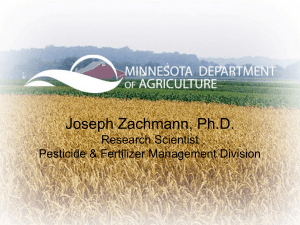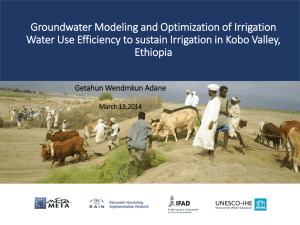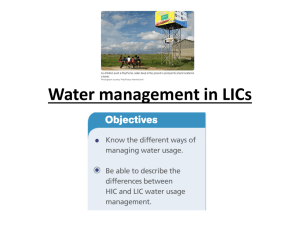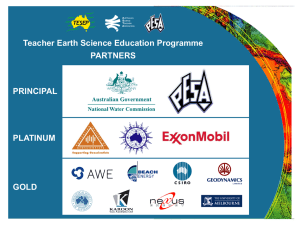ppt
advertisement
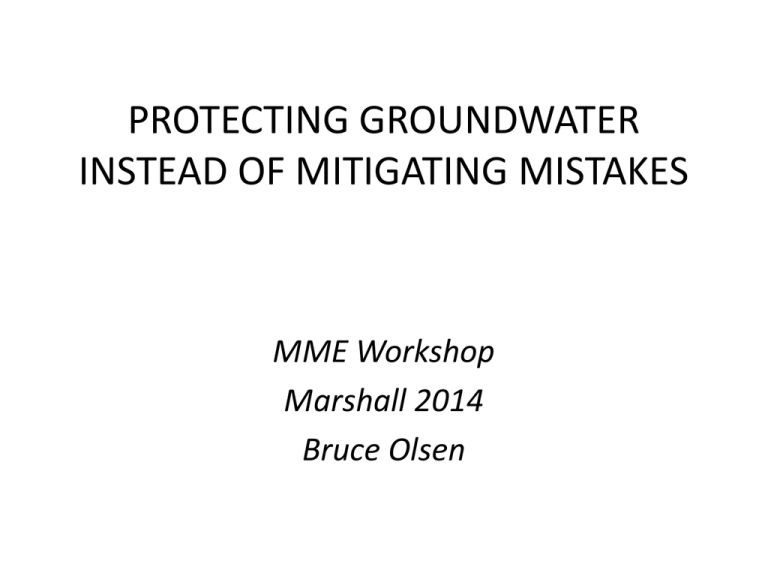
PROTECTING GROUNDWATER INSTEAD OF MITIGATING MISTAKES MME Workshop Marshall 2014 Bruce Olsen WHY PROTECT GROUNDWATER? • • • • • • Principal Source of Drinking Water in MN Recharges Many Lakes and Streams Extensively Used to Irrigate Crops Supports Habitat for Many Plants and Animals Heavily Used for Industry in Some Places More Dependable Water Supply Than Surface Water WHAT ARE THE PROBLEMS? • Over Use – Pumping More Than is Replaced • Misuse (Wasting) – Pumping for a Less Important Need • Contamination – Introducing a Substance that Makes Groundwater Unusable for Others • Knowledge Gap – Detailed Information About the Resource is Lacking in Many Areas • User Awareness – Limited Understanding of Cause and Effect WHERE MINNESOTANS GO FOR A DRINK OF WATER • Approximately 4,000,000 Obtain Their Drinking Water from a Public Water Supply – 1,000,000 From Surface Water – 3,000,000 From Wells • 1,350,000 Obtain Their Drinking Water from a Private Well PUBLIC WATER SUPPLY SYSTEMS • Community Systems 970 • Nontransient Systems 657 • Transient Systems 6,977 8,604 Total LAND OF 10,000 LAKES & PUBLIC WATER SUPPLY WELLS There Are As Many Public Water Supply Wells As There Are Lakes In Minnesota RESIDENTIAL WELLS • Approximately 1,350,000 Minnesotans Use Private Wells • Well Drilling Began Late 1800’s • State Construction Regulations in 1975 • No State or Federal Monitoring • Generally, 20% Show Nitrate Contamination • Generally, 5% Show Bacterial Contamination COUNTY WELL INDEX • • • • • • Web Site for Retrieving Well Records Public Water Supply Wells Not Shown Operated by MGS and MDH Mapping Service Linked to Records Contains Approximately 450,000 Records Principle Source of Subsurface Data for Minnesota PUMPING PROBLEMS • Impacts on Surface Water – White Bear Lake (city pumping), Straight River (irrigation), Savage Fen (city pumping) • Impacts on Groundwater – Granite Falls (ethanol plant), Brooten-Belgrade Area (irrigation), Downtown MPLS-STP (air conditioning) CONTROLLING PUMPING • DNR Regulates Wells that Pump 10,000 gallons/day or 1,000,000 gallons/year • 11,742 Active Appropriations Permits • Pumping Categories for 2011 – Public Water Supply – Industrial Processing – Irrigation – Other 199 billion gal/year 103 73 72 447 billion gal/year CONVERSION EXERCISE If an acre foot (1 foot of water deep over an acre) = 325,853 gallons How many acre feet are in 447 billion gallons? 1,371,784 acre feet If the area of Lyon County is 461,734 acres, how many feet of water could be applied in 447 billion gallons? 2.97 feet over the entire county 214.34 feet over the city of Marshall (6,400 acres) UNDERSTANDING THE CONTAINER • A Geologic Model is Key to Estimating the Available Quantity of Groundwater • Geologic Materials Affect the Directions and Rates of Groundwater Flow and Water Quality • Geologic Conditions Affect Well Construction and Operating Costs • Understanding Geologic Conditions Affects the Accuracy of Computer Models & GW Management MAYONAISE JAR AQUIFER LESSON 1 • Help the Student Understand – How groundwater is stored in a gravel or sand aquifer – How differences in geologic materials impact the amount of available groundwater • Uses inexpensive and readily available materials • Discussion Items for the Instructor LESSON 1 COUNTY-LEVEL GROUNDWATER CONDITIONS & ISSUES • Dakota County is Located in the SE Part of the Twin Cities Area • Groundwater is the Principle Source of Drinking Water • Mixed Urban and Rural Setting • Rapidly Expanding Population in the Previous 20 Years • Groundwater Quantity and Quality Concerns Ground Water Appropriations Permits for Wells that Pump 10,000 Gallons/Day or 1,000,000 Gallons/Year Glacial Wells Versus Depth to Bedrock 51 – 100 Feet 0 – 50 Feet Bedrock Geology Aquifer Materials Comprise the Uppermost Bedrock Throughout Most of the County Source – Metropolitan Council Prairie Du Chien – Jordan Aquifer Hydraulic Head (Feet MSL) Not Present Geologically Sensitive Tritium Levels Prairie du Chien - Jordan Post-1953 Recharge Pre-1953 Recharge Water Table Vulnerability 1 = Lowest 2 3 4 = Highest Nitrate Levels in Public Water Supply Wells > 10 ppm > 1 < 10 ppm < 1 ppm Potential Contamination Sources Referenced to Water Table Vulnerability Leaking Tank Site Permitted Feedlot FILLING THE KNOWLEDGE GAP • Upgrading the County Well Index (MGS,MDH) • Expanding the County Geologic Atlas Program (MGS,DNR) • Expanding Water Level Monitoring Program (DNR, County Cooperators, USGS) • Expanding Characterization of Groundwater Chemistry (DNR, MPCA, MDH, MDA) • Improving Web Access to Agency Data WELL……………… • A Well is “an excavation that is drilled, cored, bored, washed, driven, dug, jetted, or otherwise constructed if the excavation is intended for the location, diversion, artificial recharge, or acquisition of groundwater.” • A Tube that is Constructed From the Land Surface to a Source of Groundwater. MAYONAISE JAR AQUIFER LESSON 2 • Help the Student Understand – How a water supply well works – How the rate of groundwater recharge affects the quantity of available groundwater • Builds on the Concepts Introduced in Lesson 1 • Discussion Items for the Instructor LESSON 2 PROBLEMS WITH OLDER WELLS • Many Pre-1975 Wells Do Not Meet Current Construction Standards and – May be susceptible to pathogen or other contamination sources – May provide pathways for contaminants to move deeper • Unused Wells Must Be Sealed • Sealing May be Very Costly ($100,000 or more for Large Diameter Wells) • > 250,000 Wells Have Been Sealed in MN Lakefield Example • Unsealed Old City Wells Presented a Threat to Existing and Planned City Wells • High Levels of Diesel Fuel Contamination in a Near-Surface Sand Surrounding City Wells • High Degree of Hydraulic Separation Between Upper Sand and Deeper Aquifer • Limited Geographic Extent to the Deeper Aquifer Lakefield City Wells Circa 2002 Current Wells Former Wells No Longer Used LAKEFIELD CITY WELL #2 Near Surface Aquifer Contaminated With Diesel Fuel from the Former City Power Plant. Two Operational and Three Unsealed Former City Wells Presented a Contamination Pathway Risk to the Aquifer. Well 2 - RUSTED LINER PIPE Hole in Casing SEALED BUT NOT FORGOTTEN 4 Wells Sealed All Within 100 Feet of Each Other “Petro-Fund” Paid for 3 of Them City Had Unforeseen Expense Sealing the Other CONTAMINATION • Human-Made or Naturally Occurring Substances – Biological (bacteria and viruses) – Chemical Contaminants (60,000+ Chemicals) – Change the Natural Chemistry of Groundwater by Mixing (Multi-aquifer Wells, Storage/Retrieval) • Generally, Analytical Methods Lag Behind Concerns Human Health Impacts • Gauge Used to Assess Extent of Contamination or Set a Remediation Goal • Maximum Contaminant Level (90 Federal) • Health Risk Limit (Minnesota) • EPA or State Approved Analytical Methods • Setting Levels is a Time Consuming Process QUESTION – CAN YOU SEE GROUNDWATER CONTAMINATION? NOT VERY OFTEN WHAT IS THE MOST COMMONLY DETECTED GW CONTAMINANT? Nitrate Nitrogen Potential Sources – • Septic Systems and Leaking Sewer Lines • Feedlots • Fertilizer Storage and Use • Stormwater Management • Infiltrating Surface Runoff Geologic Sensitivity of the Water Table ASSUMPTION: Red Colored Areas Should Show Areas Where the Water Table Is Most Likely To Be Impacted By Nitrate Sources. Nitrate Detections Versus Water Table Sensitivity Data Sets – 7,194 of 63,164 CWI Records 1,336 of 17,291 PWS Sources Assessing Contaminant Levels • Informal (County-level Well Testing, Nitrate Clinics, County Geologic Atlas, USGS studies, Research by Academia, Real Estate Transactions, Legislative Initiative) • Regulatory (Well Construction, Remediation Programs, Permitting Programs, Public Water Supply Program, Nitrate Monitoring Network, MCL-HRL Development) ADDRESSING CONTAMINATION • • • • • Assessment (Initial and Long-term) Regulatory Clean Up Voluntary Clean Up Adding Treatment to Existing Water Systems Replacing Wells (Replacement or Alternate Supply) • Reducing Pumping – Adding Other Sources MAYONAISSE JAR AQUFIER LESSON 3 • Help the Student Understand – The water table – How pumping can move contamination deeper into an aquifer • Builds on the Concepts Introduced in Lessons 1&2 • Discussion Items for the Instructor LESSON 3 CONTAMINATION IS EXPENSIVE • Replacing a Contaminated Well – $30,000 to $500,000 for a community well – $5,000 to $15,000 for a private well – $5,000 or more to hook up to a community supply • Adding and Maintaining Treatment – $150,000 to > $10 million for a city – $1,000 to > $5,000 for a home owner EXAMPLES OF CLEAN UP COSTS • Nationally, EPA Spent $40 billion on Superfund since 1986 ($243 Million Annual Budget Now) • Minnesota – Closed Landfill program (109 sites) • $41,117,309 for reimbursements since 1986 • $16,847,085 in 2013 for administration – Petroleum Remediation • $40 milion in Petrofund reimbursements since 1987 • Clean up for Contaminated GW is typically $100,000 $1million per site (EPA) DEEPER AQUIFERS HAVE OTHER EXPENSIVE PROBLEMS • Limited Geographic Extent or Varying Geology – Test Drilling and Test Pumping – Extend Water Lines to New Well(s) • Different Chemistry Requiring Treatment – Iron and Manganese – Arsenic or Radium – More Corrosive than Shallow Aquifer Water • State Regulations May Limit or Prohibit Their Use PREVENTING CONTAMINATION USING REGULATIONS • Regulatory Programs – (Wells, Fuel & Chemical Storage Tanks, Feedlots, Aggregate Mining, Solid Waste Handling & Disposal, Hazardous Waste Handling & Disposal, Pipelines, etc.) • Some Programs Omit Smaller Sizes • Pre-existing Sources may be “Grandfathered In” • Some Contaminant Sources May Not be Formally Included • New Contaminants of Concern May Mean Unregulated Sources PREVENTION NON-REGULATORY APPROACHES • Well Owner Education (MDH, County Health Agencies, USDA ) • County-Level Water Planning (BWSR, Counties) • Source Water Protection (MDH, PWS) • Groundwater Management Areas (DNR, StateLocal Agencies, General Public) PUBLIC EDUCATION • Generally, Event Focused Instead of Curriculum Focused • Conferences (MRWA, AWWA, MWWA, MGWA, U of M) Enough acronyms for you? • Public Places/Events (County Fairs, State Fair, Museums, Agency Hallways or Lobbies) • Educator Workshops (MMEW, Drinking Water Institute) EDUCATION GAP REGARDING GROUNDWATER PROTECTION • No State-wide Strategy for Educating the General Public About Groundwater Protection • No Thorough Evaluation of the Effectiveness of Current or Previous Education Efforts • No Formal Steering/Advisory Group Tasked with Defining and Meeting the Public Education Needs about Protecting Groundwater Let’s Start at the Well Maintain Setback Distances From Potential Contamination Sources Listed in the State Water Well Code OK, What’s the Problem? Well USUALLY, IT’S MORE SUBTLE PROTECTING YOUR HOUSE WELL • Well Owner’s Handbook (MDH Home Page » Environments and Your Health » Water » Wells» Well Owner’s Handbook) • Primer Describing – – – – – – Groundwater Well Construction Water Treatment Contaminants Well Maintenance Water Testing Groundwater FINDING YOUR WELL RECORD • Search “County Well Index” • See if a Well Record Exists (Search “County Well Index”) • Is there a layer of clay at least 10 feet thick? • If not, the aquifer is geologically sensitive • If your can’t find a well record, consider the aquifer geologically sensitive • Test the Water for Nitrate and Coliform Bacteria (Indicators of Rapid Recharge) PROTECTING YOUR HOUSE WELL • Do Not – – Allow Surface Drainage to Pond Around the Well – Remove the Well Cap – Mix Lawn Chemicals Next to the Well – Park or Wash Vehicles Next to the Well – Tie the Dog to the Well Casing – Cover the Well with Soil or Build Over It • Maintain Setback Distances Listed in the Well Owner’s Handbook PROTECTING COMMUNITY OR SCHOOL WELLS • Source Water Assessment • Wellhead Protection Plan – – – – – Identifies Well Capture Area (10 Year Minimum) Assessment of Well and Aquifer Vulnerability Inventory of Potential Contamination Sources Management Strategy (Includes Education Plan) Contingency Plan • Inner Wellhead Management Area – 200 Foot Radius – Linked to the Sanitary Survey SOURCE WATER ASSESSMENT • Provides an Evaluation of Contamination Risk to Public Water Supply Wells • Minnesota Department of Health Home Page » Environments and Your Health» Water» Drinking Water » Source Water Assessments • Search by Name or County MAYONAISE JAR AQUIFER LESSON 4 • Help the Student Understand the Challenges of – Managing potential contamination sources that may affect a city well – Preventing contamination in the future • Based Upon Actual Problems • Discussion Items for the Instructor LESSON 4 QUESTIONS




